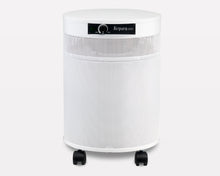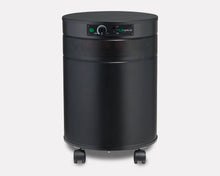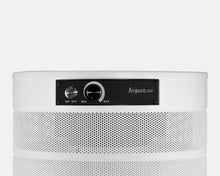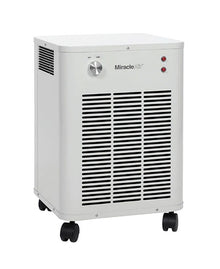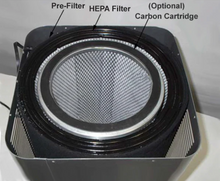VOCs and Airborne Chemical Contaminants: A Business Owner's Guide to Workplace Protection

Small business owners often focus on visible workplace hazards—the obvious dangers that OSHA inspectors check for during routine visits. But there's an invisible threat that could be compromising your employees' health and your business's liability exposure every single day: volatile organic compounds (VOCs) and other airborne chemical contaminants.
Whether you run a hair salon, auto repair shop, cleaning service, or manufacturing facility, understanding these hidden air quality risks isn't just about compliance—it's about protecting your team's wellbeing and your business's future. This guide will walk you through everything you need to know about identifying, managing, and eliminating these workplace air quality threats.
The Hidden Danger in Your Workplace Air
Volatile organic compounds are exactly what their name suggests: organic chemicals that easily evaporate into the air around us. But here's what makes them particularly concerning for business owners—studies have found that levels of several organics average 2 to 5 times higher indoors than outdoors. This means your workplace could have significantly elevated levels of these potentially harmful chemicals compared to the outdoor environment.
The scope of this issue extends far beyond what most business owners realize. Recent research indicates that between 36.4% and 39.7% of the global population was exposed to harmful VOC levels, highlighting just how widespread this problem has become across different industries and regions.
What makes VOCs particularly challenging for small businesses is their ubiquity. Many VOCs are human-made chemicals that are used and produced in the manufacture of paints, pharmaceuticals, and refrigerants, but they're also found in everyday workplace products that your business likely uses regularly.
The financial implications are significant too. The VOC treatment market is experiencing explosive growth, with the Worldwide Volatile Organic Compounds (VOCs) Treatment Market expected to grow at a booming CAGR of 28.6% during 2024-2030. This rapid expansion reflects increasing regulatory pressure and growing awareness of health risks—trends that directly impact small business compliance requirements.
Understanding the Source: Where VOCs Hide in Your Business
The most insidious aspect of VOC contamination is how it infiltrates workplaces through seemingly harmless, everyday products. VOCs are in thousands of daily use products, including paint, varnish, wax, and various cleaning, degreasing, and cosmetic products. For many small businesses, this means your standard operating procedures could be continuously introducing these compounds into your workplace air.
Common Business Sources of VOC Exposure
Office and Retail Environments: Even traditional office spaces aren't immune to VOC exposure. Cleaning products, office furniture, carpeting, copy machines, and even air fresheners can release significant amounts of these compounds. The "new office smell" that many people associate with fresh renovations is often a mixture of VOCs from adhesives, paints, and synthetic materials.
Service Industry Hotspots: Hair salons represent a particularly high-risk environment. Recent research specifically examining area air monitoring of 14 VOCs in three salons serving Black women ("Black salons"), three Dominican salons predominantly serving Latino and Black women revealed concerning exposure levels. The chemical treatments, hair products, and styling tools commonly used in these businesses can create a perfect storm of VOC exposure.
Manufacturing and Industrial Operations: VOC vapors are emitted into the air by dry cleaners, auto-body shops, painting and coating facilities, and gas engines. These industries face the highest risk levels, but they're also the most likely to have existing ventilation systems and safety protocols in place.
The Concentration Effect: What many business owners don't realize is that workplace activities can create extreme spikes in VOC levels. During and for several hours immediately after certain activities, such as paint stripping, levels may be 1,000 times higher than normal background levels. This means that even occasional activities can create significant exposure events for your employees.
The Health Impact: Why This Matters for Your Business
The health implications of VOC exposure extend far beyond immediate discomfort, creating both short-term operational challenges and long-term liability concerns for business owners.
Immediate Health Effects
Some VOCs are extremely dangerous and can pose serious health risks including cancer. But the immediate effects often manifest as productivity-draining symptoms that business owners might not connect to air quality issues.
Employees exposed to elevated VOC levels commonly experience headaches, dizziness, fatigue, and respiratory irritation. These symptoms don't just affect individual wellbeing—they directly impact workplace productivity, increase sick leave usage, and can contribute to higher employee turnover rates.
Vulnerable Populations
Several studies suggest that exposure to VOCs may make symptoms worse for people with asthma or who are particularly sensitive to chemicals. This creates particular challenges for businesses, as you may have employees with pre-existing conditions who are more susceptible to VOC-related health issues.
Long-term Health Implications
The long-term health risks associated with chronic VOC exposure include increased cancer risk, reproductive health issues, and respiratory system damage. For business owners, this translates into potential workers' compensation claims, increased health insurance costs, and possible legal liability if exposure levels exceed safe thresholds.
The Cumulative Effect
VOCs derive from a variety of sources including cleaning products, cooking practices, fragrances and fresheners, hobbies and at-home work behaviors. This means your employees aren't just exposed to VOCs in your workplace—they're experiencing cumulative exposure from multiple sources throughout their day, making workplace controls even more critical for their overall health.
Regulatory Landscape: What Small Businesses Need to Know
Understanding the regulatory environment around VOCs is crucial for small business compliance, but the landscape can be complex and varies significantly based on your industry and location.
OSHA Requirements
While OSHA doesn't have a single, comprehensive VOC standard, they do regulate many individual compounds commonly found in workplace air. The Occupational Safety and Health Administration sets permissible exposure limits (PELs) for specific chemicals, and businesses are required to keep exposure levels below these thresholds.
State and Local Regulations
Many states have implemented stricter VOC regulations than federal requirements, particularly in areas with air quality challenges. California, for example, has some of the most stringent VOC emission standards in the country, affecting everything from cleaning products to furniture adhesives.
Industry-Specific Requirements
Certain industries face additional regulatory scrutiny. Auto body shops, dry cleaners, and printing facilities often have specific VOC emission limits and reporting requirements. Hair salons and beauty businesses are increasingly subject to indoor air quality regulations, particularly in metropolitan areas.
Liability Considerations
Even if your business currently complies with all applicable regulations, the trend toward stricter standards means that today's compliant operation could face future challenges. Additionally, demonstrating proactive air quality management can be crucial if employee health issues arise and litigation becomes a concern.
Practical Solutions: Protecting Your Workplace and Your Business
The good news is that minimising the risks, however, just takes a little understanding and some extra consideration when choosing things like solvents, cleaners, paints and other products. Small businesses can implement effective VOC management strategies without breaking the budget.
Source Control: The First Line of Defense
Product Selection Strategy: The most cost-effective approach to VOC management is preventing them from entering your workplace in the first place. When purchasing cleaning products, paints, adhesives, or other potentially problematic materials, look for low-VOC or VOC-free alternatives. Many manufacturers now offer formulations specifically designed to reduce volatile organic compound emissions.
Storage and Handling Protocols: Proper storage of VOC-containing products can dramatically reduce workplace exposure. Store these materials in well-ventilated areas away from employee work zones, ensure containers are properly sealed when not in use, and implement inventory rotation to prevent older products from deteriorating and releasing additional compounds.
Timing and Scheduling: Plan high-VOC activities for times when the workplace is less occupied or when natural ventilation is most effective. This is particularly important for activities like painting, floor refinishing, or deep cleaning with strong chemicals.
Ventilation Solutions: Engineering Controls That Work
Natural Ventilation Optimization: Before investing in expensive mechanical systems, maximize your existing ventilation potential. Strategic placement of fans, proper use of windows and doors, and understanding airflow patterns in your space can significantly improve air circulation and reduce VOC concentrations.
Targeted Mechanical Ventilation: For businesses with consistent VOC exposure, targeted exhaust ventilation at the source of emissions can be highly effective. This might mean installing exhaust fans near chemical storage areas, adding local exhaust ventilation to specific work stations, or upgrading existing HVAC systems with enhanced filtration.
Air Purification Technology: Modern air purification systems can provide an additional layer of protection against VOCs and other airborne contaminants. When selecting air purification solutions, look for systems that specifically address volatile organic compounds, not just particulate matter. Technologies like activated carbon filtration and photocatalytic oxidation can be particularly effective for VOC removal.
Solutions like air purifiers can help when implemented as part of a comprehensive air quality management strategy. The key is choosing the right technology for your specific workplace challenges and ensuring proper sizing and placement for maximum effectiveness.
Administrative Controls: Policies That Protect
Employee Training Programs: Educate your team about VOC sources, health risks, and proper handling procedures. This training should cover product selection, storage protocols, personal protective equipment usage, and procedures for reporting air quality concerns.
Health Monitoring: Implement basic health monitoring protocols to identify potential VOC-related health issues early. This might include regular check-ins about symptoms like headaches or respiratory irritation, particularly after high-exposure activities.
Exposure Documentation: Maintain records of VOC-containing products used in your workplace, when and how they're used, and any employee health concerns that might be related to air quality. This documentation can be crucial for regulatory compliance and liability protection.
Personal Protective Equipment: The Last Resort
While engineering and administrative controls should be your primary focus, appropriate personal protective equipment can provide additional protection during high-exposure activities. This might include respirators for employees working directly with VOC-containing materials or protective clothing to prevent skin absorption.
Building Your VOC Management Plan
Creating an effective VOC management strategy requires a systematic approach tailored to your specific business needs and risk profile.
Assessment and Planning Phase
Start with a thorough evaluation of your current workplace air quality risks. Walk through your facility and identify all potential VOC sources, from cleaning supplies to manufacturing processes. Consider hiring a professional indoor air quality consultant for a comprehensive assessment, particularly if your business operates in a high-risk industry.
Document your findings and prioritize risks based on exposure frequency, concentration levels, and number of affected employees. This risk assessment will guide your investment decisions and help you focus on the most critical issues first.
Implementation Strategy
Develop a phased implementation plan that addresses the highest-priority issues first while building toward comprehensive air quality management. Start with source control measures that provide immediate benefits and require minimal investment, then progress to more complex engineering solutions as budget and operational requirements allow.
Set clear timelines, assign responsibilities, and establish measurable goals for your VOC reduction efforts. This might include targets for reducing VOC-containing product usage, improving ventilation system performance, or achieving specific air quality metrics.
Monitoring and Maintenance
Establish regular monitoring procedures to ensure your VOC management strategies remain effective over time. This should include periodic air quality testing, equipment maintenance schedules, and regular review of product selection and usage patterns.
Consider implementing employee feedback systems to identify new air quality concerns as they arise and to gauge the effectiveness of implemented solutions.
Advanced Strategies for High-Risk Businesses
Some businesses face elevated VOC exposure risks that require more sophisticated management approaches.
Professional Air Quality Assessment
For businesses in high-risk industries or those with complex chemical exposures, professional air quality assessment can provide crucial insights. These assessments typically include comprehensive air sampling, identification of specific contaminants, and recommendations for targeted solutions.
Continuous Monitoring Systems
Advanced air quality monitoring systems can provide real-time data on VOC levels, allowing for immediate response to exposure events and ongoing optimization of control measures. These systems are particularly valuable for businesses with variable exposure patterns or multiple potential sources.
Specialized Filtration and Purification
High-risk businesses may benefit from industrial-grade air purification systems designed specifically for VOC removal. These systems often combine multiple technologies and can be integrated into existing HVAC systems for comprehensive workplace protection.
Cost-Benefit Analysis: The Business Case for VOC Management
Investing in VOC management isn't just about compliance and employee health—it's a sound business decision that can provide significant returns.
Direct Cost Savings
Effective VOC management can reduce healthcare costs, workers' compensation claims, and sick leave usage. Additionally, improved air quality often leads to increased productivity and reduced employee turnover, providing measurable financial benefits.
Risk Mitigation
Proactive VOC management protects against potential regulatory fines, litigation costs, and business interruption from health-related issues. The cost of prevention is almost always lower than the cost of remediation and liability management.
Competitive Advantage
Businesses that prioritize employee health and environmental responsibility often find advantages in recruitment, customer relations, and business partnerships. This can be particularly valuable in industries where environmental consciousness is increasingly important to customers and partners.
Future-Proofing Your Business
The regulatory landscape around VOCs continues to evolve, with trends pointing toward stricter standards and increased enforcement. Businesses that get ahead of these trends will be better positioned for long-term success.
Regulatory Trends
Expect continued tightening of VOC emission standards, particularly in metropolitan areas with air quality challenges. Many jurisdictions are also expanding the scope of businesses subject to VOC regulations, potentially affecting industries that haven't faced these requirements in the past.
Technology Developments
Air purification and monitoring technologies continue to advance, offering more effective and affordable solutions for small businesses. Staying informed about these developments can help you upgrade your systems cost-effectively as new options become available.
Market Pressures
Consumer awareness of indoor air quality issues is growing, potentially creating market pressures for businesses to demonstrate their commitment to employee and customer health. This trend is particularly evident in service industries where customers spend time in business facilities.
Taking Action: Your Next Steps
Protecting your workplace from VOCs and airborne chemical contaminants doesn't have to be overwhelming or expensive. Start with a systematic assessment of your current risks and implement solutions based on your specific needs and budget constraints.
Begin with source control measures that provide immediate benefits—reviewing your product selection, improving storage practices, and optimizing natural ventilation. These steps alone can significantly reduce VOC exposure in many small business environments.
As you build your VOC management program, remember that this is an ongoing process, not a one-time fix. Regular assessment, employee feedback, and continuous improvement will help ensure your air quality management strategies remain effective as your business grows and evolves.
The investment you make in workplace air quality today will pay dividends in employee health, regulatory compliance, and business sustainability for years to come. Your employees' wellbeing and your business's future both depend on the air quality decisions you make today.
Frequently Asked Questions About VOCs in Small Businesses
Q: How do I know if my business has a VOC problem? A: Common signs include employee complaints of headaches, dizziness, or respiratory irritation, particularly after using certain products or during specific activities. Strong chemical odors, even if they seem "normal" for your industry, can also indicate elevated VOC levels.
Q: Are natural or "green" products always VOC-free? A: Not necessarily. While many green products have lower VOC levels, some natural compounds can still be volatile organic compounds. Always check product labels and safety data sheets for specific VOC content information.
Q: Do I need professional air quality testing for my small business? A: Professional testing is recommended for high-risk industries or if employees are experiencing health symptoms that might be related to air quality. For lower-risk businesses, starting with product assessment and basic ventilation improvements is often sufficient.
Q: How much should I expect to spend on VOC management? A: Costs vary widely based on your business type and current exposure levels. Source control measures (better product selection, improved storage) often cost very little, while comprehensive air purification systems can range from hundreds to thousands of dollars depending on facility size and requirements.
Q: Can air purifiers really help with VOCs? A: Yes, but not all air purifiers are effective against VOCs. Look for systems with activated carbon filtration or photocatalytic oxidation specifically designed for volatile organic compound removal.
Sources:
- Environmental Protection Agency (EPA). "Volatile Organic Compounds' Impact on Indoor Air Quality." August 13, 2024. https://www.epa.gov/indoor-air-quality-iaq/volatile-organic-compounds-impact-indoor-air-quality
- Scientific Reports. "Increased long-term health risks attributable to select volatile organic compounds in residential indoor air in southeast Louisiana." Nature Portfolio, 2020.
- npj Climate and Atmospheric Science. "One-third of global population at cancer risk due to elevated volatile organic compounds levels." Nature Portfolio, 2024.
This article is for informational purposes only and does not constitute professional health or safety advice. Consult with qualified professionals for specific workplace safety assessments and recommendations.

